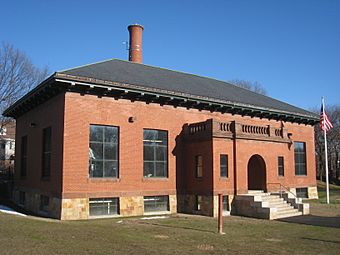Arlington Pumping Station facts for kids
Quick facts for kids |
|
|
Arlington Pumping Station
|
|
 |
|
| Location | Arlington, Massachusetts |
|---|---|
| Built | 1907 |
| Architect | Dodge, C.A. |
| Architectural style | Renaissance |
| MPS | Arlington MRA |
| NRHP reference No. | 85001022 |
| Added to NRHP | April 18, 1985 |
The Arlington Pumping Station is a historic building in Arlington, Massachusetts. It was built in 1907. Its main job was to pump water to the town of Lexington. It also supplied water to higher parts of Arlington. The station started working on December 4, 1907.
Contents
Building the Station
The Arlington Pumping Station was designed by CA Dodge & Co. Construction started on August 23, 1906. It is a strong brick building. It measures about 90 feet (27 meters) long and 46 feet (14 meters) wide. The building stands about 26 feet (8 meters) tall to its roofline.
Materials and Design
The foundation walls are made of strong concrete. The parts you can see from the outside are covered with granite. The outside walls are made of dark-red bricks. They have brownstone decorations. The roof is a hip roof, meaning it slopes on all four sides. It is supported by steel beams and covered with slate tiles. The steps at the main entrance are made of pink granite.
Inside the Station
The building is divided into two main parts. There is an engine room and a boiler room. The engine room is about 48 feet (15 meters) long and 40 feet (12 meters) wide. It is 24 feet (7 meters) high. The boiler room is about 40 feet (12 meters) long and 35 feet (11 meters) wide. It is 33 feet (10 meters) high. Both rooms have red brick walls inside. The engine room floor is made of red tiles.
Behind the boiler room, there was an underground area for coal. This "coal pocket" was about 33 feet (10 meters) long. It was 27 feet (8 meters) wide and 10 feet (3 meters) high. A concrete roof covered it. This roof had openings to unload coal from train cars. A tall brick chimney is at the back of the building. It is 70 feet (21 meters) high.
The main entrance is at the front of the building. It has a small entry area. On each side of this area are an office and a restroom.
How the Pumping Station Worked
The station used powerful machines to move water. The Allis-Chalmers Company provided some of the main pumping equipment. This included a large engine connected to two pumps. These pumps could move 1,500,000 gallons (about 5.7 million liters) of water in 24 hours.
Another company, Blake & Knowles Steam Pump Works, also installed an engine and pumps. This system could also pump 1,500,000 gallons of water per day.
Boilers and Power
The station had two large boilers. Boilers heat water to create steam. This steam powered the engines that ran the pumps. Each boiler was about 54 inches (1.4 meters) in diameter. They contained many long tubes. The furnaces had special grates to help burn the coal efficiently.



